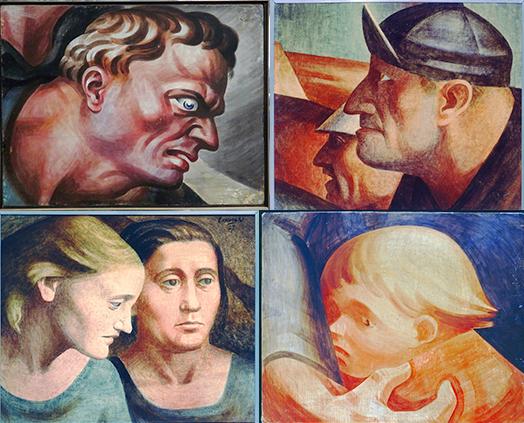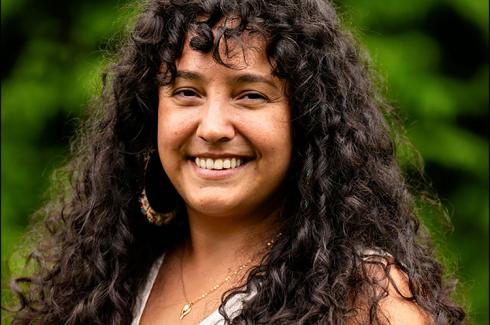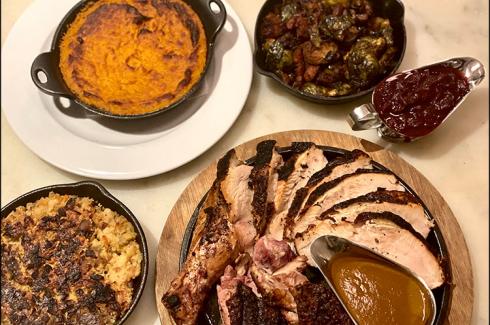The Pollock-Krasner House and Study Center in Springs is having a "friendship circle" season. First up was Terence Netter, a friend of Lee Krasner's whose work was shown through the end of July. Currently, it is one of Jackson Pollock's earliest friends, Harold Lehman, whose paintings hang on the Pollock-Krasner walls.
It may be jarring to see so much figurative work in a setting that usually holds more nonobjective paintings and drawings. The art in this show, "Harold Lehman: The Nineteen Thirties," is focused on that era and some of the preparatory studies he made for a mural that no longer exists. "Man's Daily Bread" was painted for the mess hall in the Men's House of Detention at Rikers Island between 1937 and 1938.
It was designed for a jail, a way station between release or prison, and was meant to be uplifting and edifying for the men, who saw it during meals three times a day. The themes were home, family, hard work, and sustenance. Workers were shown harvesting and processing the materials for a loaf of bread that sits at the center of the mural, placed on a table around which a family has gathered.
Like altarpieces and chapel decorations that illustrated biblical stories from centuries past, there is a similar intent and moral framework implied, a nondenominational call to our better selves that still has some resonance, even if only in a nostalgic, dawn of the "Greatest Generation" kind of way.
Seventy feet across and 20 feet high, it was painted onsite using canvas panels but removed at some point in the 1960s. It has not been recovered. Fortunately for us, a photograph of it exists and was blown up for the show. It is placed on a prominent wall in the exhibition to help recreate some of its hefty visual impact.
Pollock and Lehman, who died in 2006 and was originally from New York City, met at the Manual Arts High School in Los Angeles when both were teens. They also befriended Philip Guston, another budding artist who as a student there was known as Philip Goldstein. Their mentor, who supplemented their studies with additional drawing classes, was the person who introduced them to the ideas of theosophy and Krishnamurti.
After high school, Lehman went on to work under David Alfaro Siqueiros, who was in Los Angeles at the time promoting the style and ideas of Mexican muralists. Under his direction, they painted portable fresco panels with themes of socialism. One of their shows was raided by the city's Red Squad of police, who destroyed the works.
In 1934, Lehman was hired by an early public works project founded under the New Deal in Los Angeles and was joined by Guston and Reuben Kadish. They did not complete the project, but it provided further experience that Lehman took back to New York with him in 1935.
After he joined the Federal Art Project in New York, he introduced Siqueiros to Pollock and his brother Sanford Pollock, who worked with them in Siqueiros's Experimental Workshop, which made public artwork with industrial materials and expressive imagery, providing tools that Pollock would later use in his best-known work.
This is a lot of background, but important context when seeing the works in the show, which seem such a product of their time and the prevailing influences of those times. Most of them are studies for the mural: heads of adults, children, workers, an elderly man. They have a late-Michelangelo Mannerist presence, archetypes for certain, in plain generalized garments. They look determined, grim, fearful, hungry, and some are maybe all of the above. Thomas Hart Benton comes to mind, which is appropriate as he taught classes in Old Masters techniques at the Art Students League, where Pollock studied under him.
There are a few other works and drawings in the show, notably a drawing of a skull that was in Pollock's studio and is now part of the house's collection. The drawing was made in 1940 with deep modeling and light and shadow in the classical sense, but it still has a modern sensibility.
A 1933 shirtless self-portrait is dominated by Lehman's enormous arm resting on a table, perhaps a casualty of foreshortening gone bad. Yet it is also heroic and protective, as he holds a canvas in that hand, telegraphing the artist as a powerful shaper of worlds and ideas.
Another portrait is of Marian Anderson from 1939, marking her concert at the Lincoln Memorial. Initially larger, the artist later cut the original board down to focus on Anderson without the distraction of the statue of Lincoln in the background.
One unrelated inclusion, "Munich Pact 1," still has activist overtones. Dating from 1938, it refers to a decision in which France, Italy, and the United Kingdom agreed not to challenge Germany's annexation of portions of Czechoslovakia. The move, taken to avoid confrontation with Hitler, ended up leading to Germany's full annexation of Czechoslovakia and the invasion of Poland in the following months. Lehman portrays a red body being decapitated by a beast on horseback, while its arms are bound by a bent umbrella, keeping it from using the sword in its hands as protection. Other smaller bodies cower under another umbrella, perhaps the next to fall.
It's a striking set of artworks, made all the more so by the infrequency of their period's appearance in East End exhibitions. Indeed, the early 20th century, post-Moran and before the postwar era, is a blip in the South Fork artistic timeline. It is a refreshing reminder of what everyone was up to in American modernist circles before the next wave hit here a decade later.
The exhibition will remain on view through October.




